
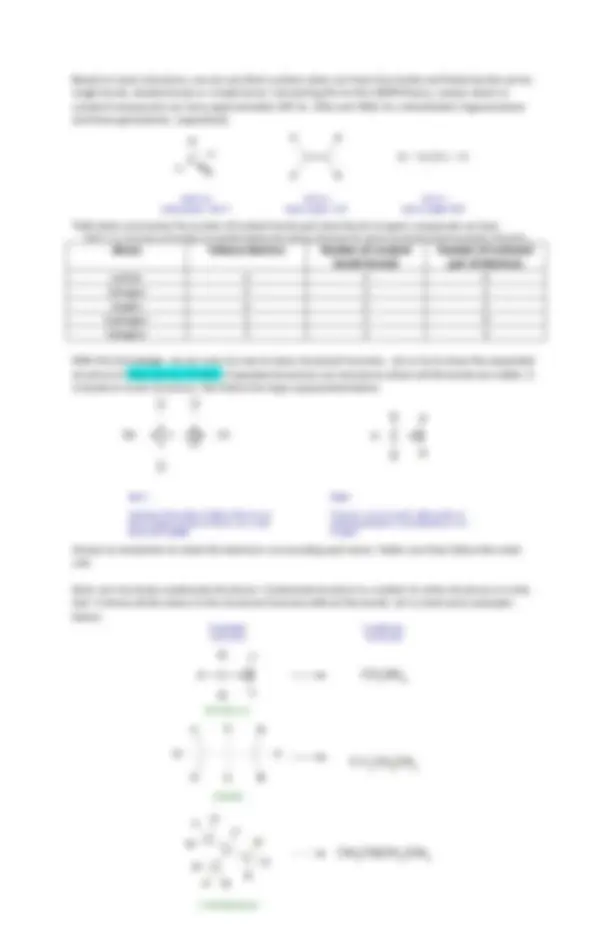
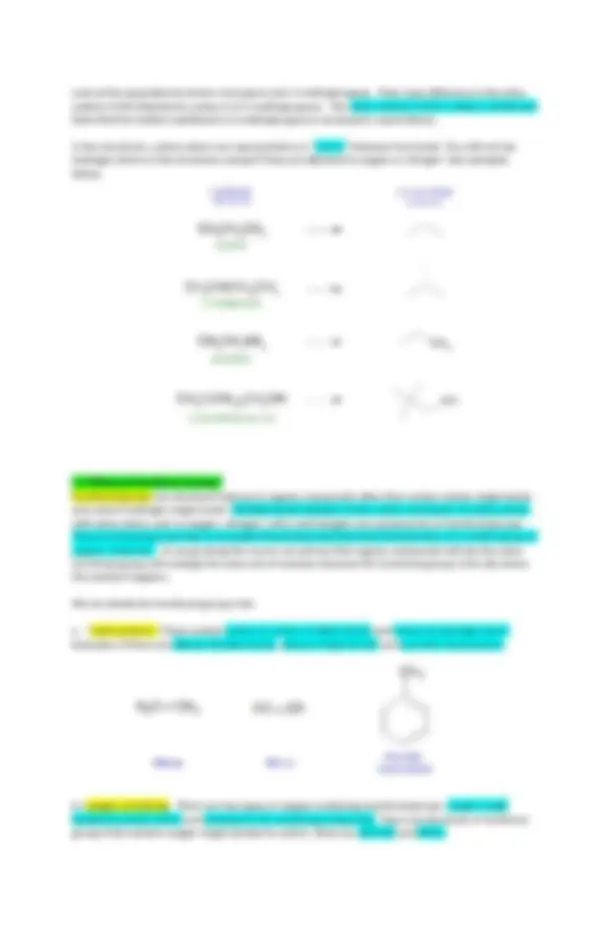
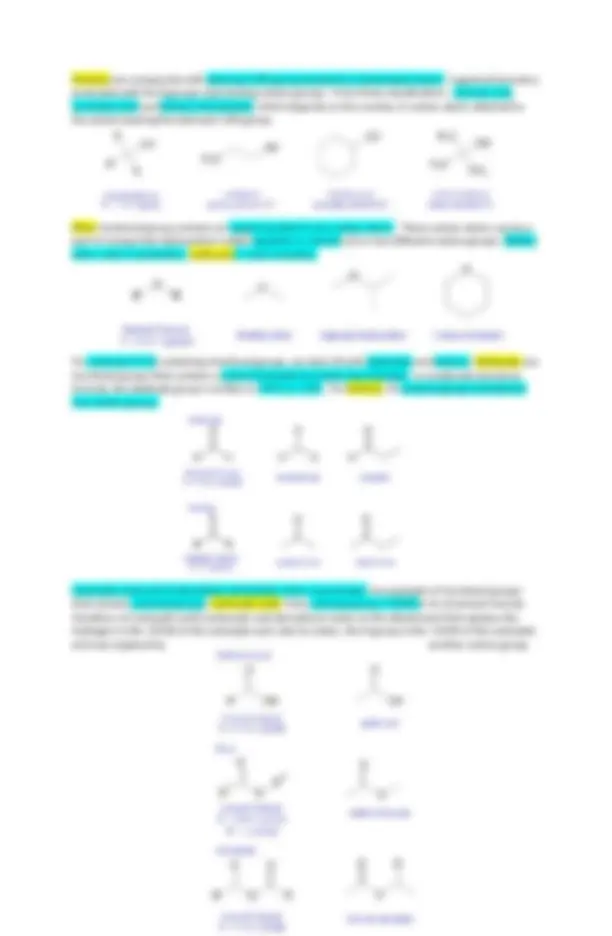
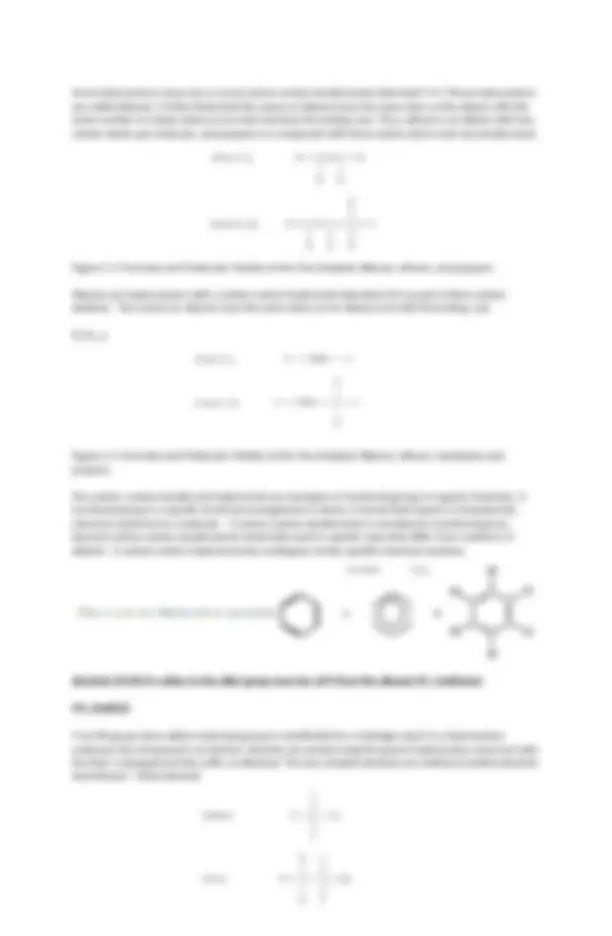
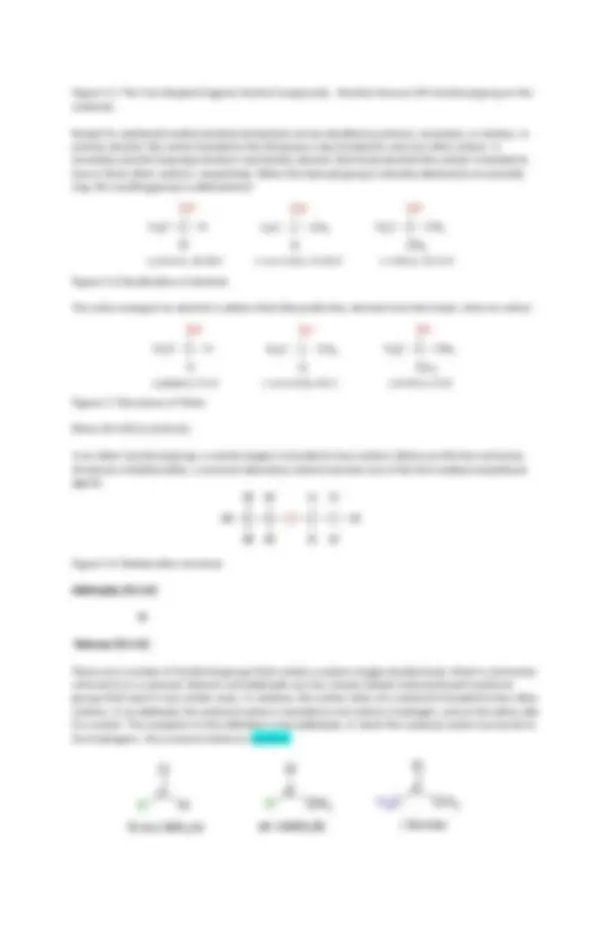
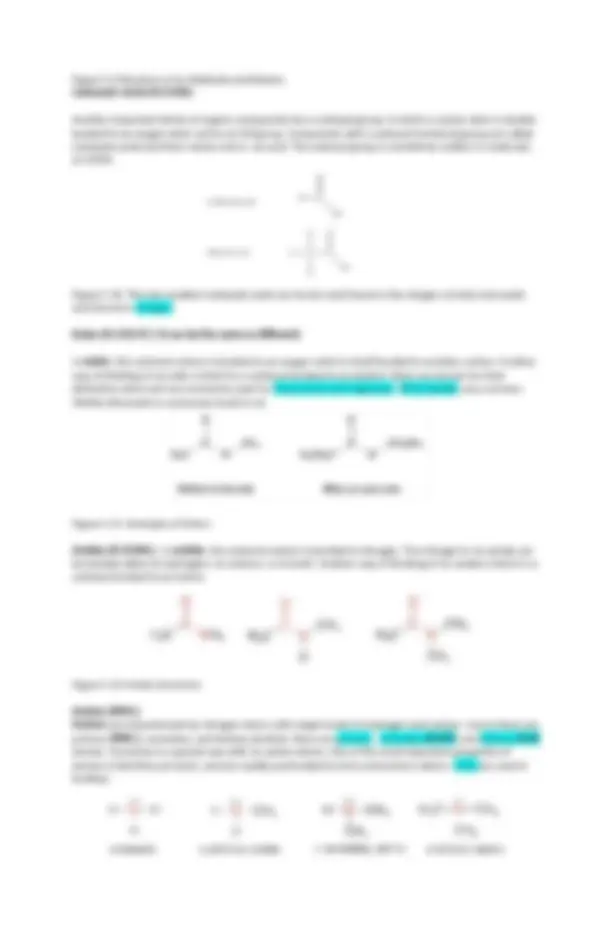


Study with the several resources on Docsity

Earn points by helping other students or get them with a premium plan


Prepare for your exams
Study with the several resources on Docsity

Earn points to download
Earn points by helping other students or get them with a premium plan
Community
Ask the community for help and clear up your study doubts
Discover the best universities in your country according to Docsity users
Free resources
Download our free guides on studying techniques, anxiety management strategies, and thesis advice from Docsity tutors
This paper will help you understand more on organic chemistry
Typology: Exercises
1 / 11

This page cannot be seen from the preview
Don't miss anything!







1.1 What are Organic Compounds? Organic chemistry is the chemistry of the compounds of carbon. They are in our food, medicines, computers and in our bodies. Though, we concentrate on the chemistry of carbon, there are other few elements that can partner with it. These are hydrogen, oxygen, nitrogen, sulfur, phosphorus and halogens (fluorine, chlorine, bromine or iodine). Carbon is not even the most abundant element in the Earth's crust, which is mostly composed of oxygen (49.5%) and silicon (25.7%). So why carbon? There are several reasons for this: a.) historical reasons In the early years of chemistry, scientist thought that all organic compounds are produced from living things while inorganic compounds are those found in rocks (non-living things). The early scientist believes that you need this "vital force", which only living thing has, to create or derive organic compounds. This theory was disproved by Friedrich Wohler. He heated an aqueous solution of ammonium chloride and silver cyanate (see Figure 1.1.1.), which both are inorganic compounds, and produced urea. This experiment provided sufficient evidence to disprove the "doctrine of vital force." A few year later, August Kekule provided a new definition to organic compounds which is widely accepted in this modern times. He defined organic compounds to be compounds that contains carbon. Figure 1.1.1. Reaction between ammonium chloride and silver cyanate. b.) large number of carbon atoms containing compounds you can create Chemist synthesize a large number of these compounds as compared to inorganic compounds. This is because of the uniqueness of the carbon's structure and bonding capabilities. Carbon has four valence electrons which can equate to four different bond points. Carbon can link together to form large number of carbon chains. c.) interest in biochemical studies This portion here is where you guys are most interested in - our biochemicals. Carbohydrates, lipids, proteins (e.g. enzymes), nucleic acids (DNA and RNA), hormones, vitamins and any other important chemical in our bodies are organic compounds. d.) difference of the properties of inorganic compounds and organic compounds A comparison of properties of Organic and Inorganic compounds Inorganic Compounds Organic Compounds Type of Bond Mostly ionic bonds Mostly covalent bonds Physical state Mostly solid Many are gases, liquids or solids Melting point Mostly very high Mostly very low (less than 360°C) Solubility in water Mostly soluble in water Mostly insoluble in water Electrical conductivity Aqueous solutions are mostly good conductor of electricity Aqueous solutions are not good conductor or electricity Flammability Very few burns Almost all burns and decompose Rate of reaction Often very fast Usually very slow Organic compounds can be sourced out in two ways, which is thru isolation from nature or synthesis from the laboratory. These two tracks are mostly how our medicines are discovered. Compounds isolated from the nature by using chromatographic techniques and are tested in vitro and/ or in vivo for bioactivity. Afterward, if compound was found to be bioactive, chemist can choose to synthesize the
compound for more massive testing. This is part of drug discovery. Drug discovery can take years to develop. 1.2 How to Write Structural Formulas? A structural formula are how we represent our molecule and help us identify the location of each chemical bonds between the atoms in a molecule. Structural formulas can be represented as expanded structures, condensed structures and skeletal or line structures. Below are different structural representation of ethanol or ethyl alcohol, the alcohol found in alcoholic beverages such as wine and beer. The VSPER Model
Look at the expanded structures of propane and 2-methylpropane. Their main difference is the extra methyl (-CH3) attached to carbon-2 of 2-methylpropane. This extra methyl (-CH3) is called a substituent. Note that the methyl substituent in 2-methylpropane is enclosed in a parenthesis. In line structures, carbon atoms are represented as a "corner" between two bonds. You will not see hydrogen atoms in line structures except if they are attached to oxygen or nitrogen. See examples below: 1.3 What are Functional Groups? Functional groups are structural features in organic compounds other than carbon-carbon single bonds and carbon-hydrogen single bonds. Multiple bonds between carbon atoms and bonds of carbon atoms with other atoms such as oxygen, nitrogen, sulfur and halogens are components of functional groups. These functional groups help us to predict the physical and chemical characteristics of a certain group of organic molecules. As we go along the course, we will see that organic compounds fall into the same functional group will undergo the same set of reactions because this functional group is the site where the reaction happens. We can divide the functional groups into: a. ) hydrocarbons. These contain carbon to carbon multiple bonds and carbon to hydrogen bond. Examples of these are alkenes (double bonds), alkynes (triple bonds) and aromatic hydrocarbons. b.) oxygen-containing. There are two types of oxygen containing functional groups: oxygen single bonded to carbon atoms and carbonyl (C=O) containing compounds. There are two kinds of functional groups that contains oxygen single bonded to carbon, these are alcohols and ethers.
Alcohols are compounds with hydroxyl (-OH) group bonded to a tetrahedral carbon. A general formula is presented with the R groups representing carbon groups. It has three classifications - primary (1o), secondary (2o) and tertiary (3o) alcohols, which depends on the number of carbon atoms attached to the carbon bearing the hydroxyl (-OH) group. Ether functional group contains an oxygen bonded to two carbon atoms. These carbon atoms can be a part of a long chain hydrocarbon (called epoxides or oxirane) (2) or two different carbon groups. Diethyl ether used in anesthetics. Isoflurane is used nowadays. For carbonyl (C=O) containing functional groups, we start off with aldehydes and ketones. Aldehydes are functional groups that contains a carbonyl bonded to at least one hydrogen. In condensed structural formula, the aldehyde group is written as CH=O or -CHO. For ketones, its carbonyl group is bonded to two carbon groups. Carboxylic acids and its derivatives (anhydride, esters and amides) are examples of functional groups that contains carbonyl groups. Carboxylic acids have carboxyl group (-COOH) in its structural formula. Variations of carboxylic acids (carboxylic acid derivatives) varies on the attachment that replaces the hydrogen in the -COOH of the carboxylic acid. Like for esters, the H group in the -COOH of the carboxylic acid was replaced by another carbon group.
Hydrocarbons are organic compounds that are entirely made up of only two kinds of atoms – carbon and hydrogen. Typically, hydrocarbons are colourless gases that have very weak odours. Hydrocarbons can feature simple or relatively complex structures and can be generally classified into four subcategories, namely alkanes, alkenes, alkynes The simplest organic compounds are hydrocarbons, compounds composed of carbon and hydrogen atoms only. Some hydrocarbons have only single bonds and appear as a chain (which can be straight- chain or can have branches) of carbon atoms also bonded to hydrogen atoms. These hydrocarbons are called alkanes (saturated hydrocarbons). Each alkane has a characteristic, systematic name depending on the number of carbon atoms in the molecule. These names consist of a stem that indicates the number of carbon atoms in the chain plus the ending -ane. The stem meth- means one carbon atom, so methane is an alkane with one carbon atom. Similarly, the stem eth- means two carbon atoms; ethane is an alkane with two carbon atoms. Continuing, the stem prop- means three carbon atoms, so propane is an alkane with three carbon atoms. This gives them a general formula: CnH2n+2. Figure 5.2 gives the formulas and the molecular models of the three simplest alkanes. Figure 5.2 The three smallest alkanes, methane, ethane, and propane. The first 10 members of this series are given in Table 5. 5.2 The First 10 Straight-Chain Alkanes.
Some hydrocarbons have one or more carbon-carbon double bonds (denoted C=C). These hydrocarbons are called alkenes.( CnH2n )Note that the names of alkenes have the same stem as the alkane with the same number of carbon atoms in its chain but have the ending -ene. Thus, ethene is an alkene with two carbon atoms per molecule, and propene is a compound with three carbon atoms and one double bond. Figure 5.3 Formulas and Molecular Models of the Two Simplest Alkenes, ethene, and propene. Alkynes are hydrocarbons with a carbon-carbon triple bond (denoted C≡C) as part of their carbon skeleton. The names for alkynes have the same stems as for alkanes but with the ending -yne. (CnH2n-2) Figure 5.4 Formulas and Molecular Models of the Two Simplest Alkynes, ethyne ( acetylene) and propyne. The carbon–carbon double and triple bonds are examples of functional groups in organic chemistry. A functional group is a specific structural arrangement of atoms or bonds that imparts a characteristic chemical reactivity to a molecule. A carbon-carbon double bond is considered a functional group because carbon-carbon double bonds chemically react in specific ways that differ from reactions of alkanes. A carbon-carbon triple bond also undergoes certain specific chemical reactions. Alcohols (R-OH) R =refers to the alkyl group (one less of H from the alkane) CH 4 (methane) CH 3 (methyl) If an OH group (also called a hydroxyl group) is substituted for a hydrogen atom in a hydrocarbon molecule, the compound is an alcohol. Alcohols are named using the parent hydrocarbon name but with the final -e dropped and the suffix -ol attached. The two simplest alcohols are methanol (methyl alcohol) and ethanol.* (ethyl alcohol)
Figure 5.9 Structure of an Aldehyde and Ketone. Carboxylic Acids (R-COOH) Another important family of organic compounds has a carboxyl group, in which a carbon atom is double- bonded to an oxygen atom and to an OH group. Compounds with a carboxyl functional group are called carboxylic acids and their names end in -oic acid. The carboxyl group is sometimes written in molecules as COOH. Figure 5.10 The two smallest carboxylic acids are formic acid (found in the stingers of ants) and acetic acid (found in vinegar). Esters (R-COO-R') ( R can be the same or different) In esters , the carbonyl carbon is bonded to an oxygen which is itself bonded to another carbon. Another way of thinking of an ester is that it is a carbonyl bonded to an alcohol. Esters are known for their distinctive odors and are commonly used for food aroma and fragrances. Ethyl acetate very common. Methyl ethanoate is commonly found in oil. Figure 5.11 Examples of Esters Amides (R-CONH 2 ). In amides , the carbonyl carbon is bonded to nitrogen. The nitrogen in an amide can be bonded either to hydrogens, to carbons, or to both. Another way of thinking of an amide is that it is a carbonyl bonded to an amine. Figure 5.12 Amide structures Amines (RNH 2 ) Amines are characterized by nitrogen atoms with single bonds to hydrogen and carbon. Just as there are primary (RNH 2 ) , secondary, and tertiary alcohols, there are primary , secondary (R 2 NH) , and tertiary (R 3 N) amines. Ammonia is a special case with no carbon atoms. One of the most important properties of amines is that they are basic, and are readily protonated to form ammonium cations. Urea are used in fertilizer.
Figure 5.13 Structures of Amines Aromatics The aromatic group is exemplified by benzene (which used to be a commonly used solvent in the organic lab, but which was shown to be carcinogenic), and naphthalene, a compound with a distinctive 'mothball' smell. Aromatic groups are planar (flat) ring structures and are widespread in nature. It is characterized by a ring of six carbon atoms, bonded by alternating single and double bonds. The six carbon atoms form a perfectly regular hexagon. All of the carbon-carbon bonds have exactly the same lengths - somewhere between single and double bonds. Figure 5.14 Benzene structure and napthalene The table here summarizes the structures discussed and examples. R-S-H Thiol - onion Table 5.3 Common functional groups with formulas and names.